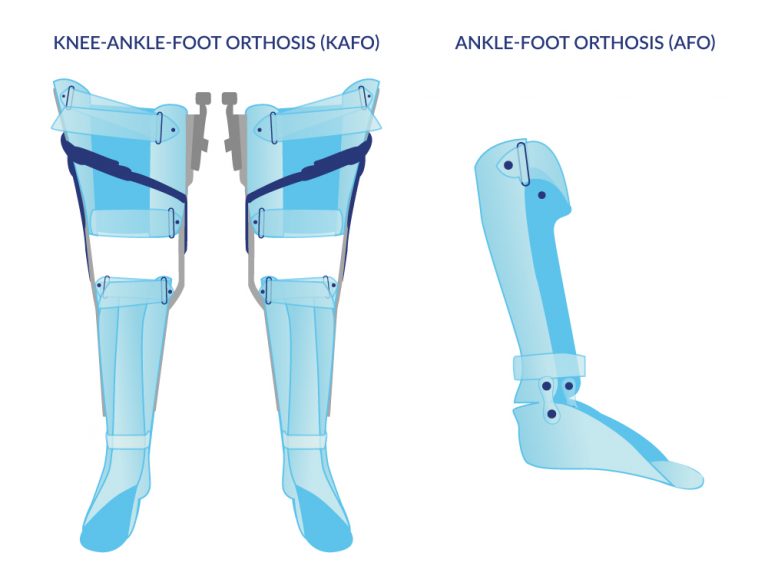Orthoses/Braces
There are several available devices used for bracing the legs in order to support standing and walking function for both complete and incomplete SCI. These range from single-joint bracing (e.g., ankle-foot orthosis [AFO]), which are usually for people with low, incomplete spinal lesions, to whole-leg/long-leg braces that extend from the lower back to the ankle.
Knee ankle-foot orthoses (KAFOs) are also used with complete injuries, and with these braces, you can sit in a wheelchair and get up and down throughout the day without risk of skin issues if they are fitted properly. With these braces, people will walk with a swing through or reciprocal stepping style, depending on the level of their injury. They require substantial upper-body strength to achieve standing. A swing through gait can tiring for the arms, and a reciprocal gait can be slow, so most people will opt for a wheelchair when long distances are required. These can be appropriate for some persons, but there has been poor adherence over the long term, with rates ranging from 32-50% (Yemisci et al. 2022; Frasunska et al. 2020). The most common reasons for discarding orthoses included difficulty in donning and doffing, limited functional improvement, high cost of devices, and wear and tear of orthoses (3%) (Yemisci et al. 2022; Frasunska et al. 2020).

Hinged Ankle-Foot Orthosis (AFO) and a Custom Knee-Ankle-Foot Orthosis (KAFO)
Many styles of AFOs and knee hyperextension braces are used to assist with standing and walking. These can be for joint protection when there is a significant muscle imbalance around a joint, such as a knee hyperextension brace (Swedish knee cage or Ossur knee sleeve, for example). Depending on an individual’s strength, tone, and ROM, there are many different AFO’s people can use, ranging from a dynamic small brace to assist with toe clearance (e.g., the Dictus) to a more rigid custom AFO to stabilize and hold the entire foot and ankle. The more rigid a brace is, the more it will impede “normal” dynamics around the joint, although this may be clinically necessary to protect the joints and provide a safe, stable base to weight bear on. These braces for the knee and lower leg may require a walking aid like the higher braces, but may be able to be used without an aid.
Braces have been advanced with powered actuators to reduce the effort required to advance the limb. Earlier models used actuators in single joints (e.g., ankle or hip), while newer models control multiple lower extremity motions. Some of the newest models utilize an exoskeleton with battery-powered motors to control multiple degrees of freedom, and the weight of the device is transferred into the ground by the exoskeleton, alleviating the participant from bearing the weight of the device. The technology of these devices appears to be the main focus of research in rehabilitation and assisted walking and ambulation in patients with SCI (Arazpour et al. 2016), hindering the progression in development of the mechanical orthoses, previously cited above.
